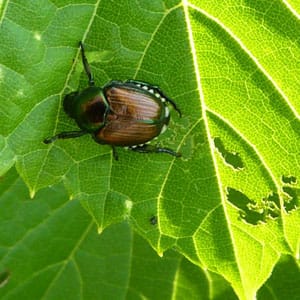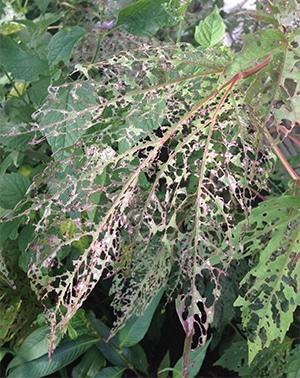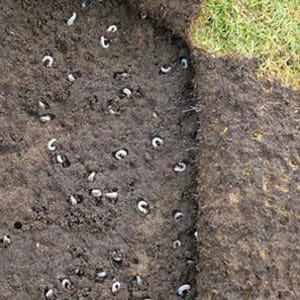Do the leaves on your shrubs and trees look like lace? If so, they’ve probably been attacked by Japanese beetles. Are brown patches appearing in your lawn? It could be grubs – the immature form of Japanese beetles.
About Japanese Beetles in New Jersey
Japanese beetles were first found in 1916 in New Jersey after being accidentally introduced to the United States from Japan. They quickly spread throughout the eastern part of the country and have since become a significant problem for many common trees, shrubs, and turf grasses.
Adult Japanese Beetles

Adult Japanese beetle
Appearance
The adult Japanese beetles are easy to spot; they’re about 1/5” long, are metallic green, have copper-brown wing covers, and show white spots along the edges of the body.
What They Eat
Adult Japanese beetles primarily eat foliage, but will also devour flowers (including rosebuds!) and fruit. They usually feed in large groups; you’ll often see whole sections of a plant covered in beetles.
Timing
In our area, adults start to emerge from the ground and begin feeding on plants in late June.
Damage
Throughout July and into August, Japanese beetles continue to feed on the tissue between the veins of leaves, giving leaves a lace-like appearance. The leaves on trees or shrubs that have been severely injured sometimes look bronze or tan when seen from a distance.
Spread
Although they’re relatively poor flyers, Japanese beetles can still travel several miles to find new food sources. Usually, though, they stay within a smaller area to feed, mate and lay eggs.
White Grubs / Beetle Larvae

Grubs are the larval form of Japanese beetles
In New Jersey, we have several types of white grubs that attack turfgrass, including:
- oriental beetles [Anomala (=Exomala) orientalis],
- Asiatic garden beetles (Maladera castanea),
- northern masked chafers (Cyclocephala borealis),
- Japanese beetles (Popillia japonica),
- green June beetles (Cotinis nitida),
- European chafers (Rhizotrogus majalis), and
- May/June beetles (Phyllophaga species).
Grubs of the oriental beetle are generally the most destructive, although Japanese beetle grubs do their fair share of damage to lawns.
Appearance
Grubs are the immature, or larval, stage of the Japanese beetle. They have a plump greyish-white body, three pairs of short, jointed legs, and a brownish head with chewing mandibles. They’re are often found curled into a C shape.
What They Eat
Japanese beetle grubs mostly attack turfgrass roots by chewing off roots close to the soil surface, although they’ll also feed on vegetables. The grubs are found in the top 2 inches of soil where they have easy access to turfgrass roots. They’re particularly active in good quality soils and irrigated lawns
Timing
Soon after adults emerge from the ground in June, they mate and begin laying eggs in the soil. Each female Japanese beetle can lay 40 to 60 eggs during her lifetime.
White grubs hatch in late July to early August and quickly grow to their full size of about 1 inch long. They immediately start feeding on plant roots, with feeding activity reaching its height in late fall.
Grubs burrow deeper into the soil as the weather cools and spend the winter deep underground. As the soil heats in spring, they resurface and resume eating until pupating into adult (beetle) form in June.
Damage
The obvious sign of grub damage is brown patches in the lawn where grass has died from grub feeding. Later in the summer, when grubs are larger and the weather tends to be hot and dry, large sections of lawn can quickly die.
In spring damage only occurs under exceptionally warm and dry conditions.
All cool-season and many warm-season grasses are susceptible to white grub damage.
Spread
Lawn grub treatments can help somewhat reduce the number of adult Japanese beetles the next year, although they’re still likely to fly in from neighboring properties. Grub treatments are usually done primarily to prevent lawn damage, rather than to control beetles.
Signs of White Grub Infestation
Early in the summer, you may see signs of infestation such as:
- gradual thinning of the lawn,
- yellowing grass,
- wilting in spite of adequate soil moisture, and
- scattered, irregular dead patches in the lawn.
As the infestation worsens and grubs start tunneling beneath the grass, you’ll see:
- dead patches of lawn grow and join together until large turf areas are affected,
- turf that feels spongy underfoot,
- large sections of lawn that can be pulled up like a carpet, and
- torn up lawn and tunnels caused by vertebrate predators (e.g., crows, skunks, raccoons, moles) feeding on the grubs.
How to Control Adult Japanese Beetles

Feeding damage caused by adult Japanese beetles.
Preventing Japanese beetles from feeding on your plants is an ongoing battle but there are some things you can do to limit the damage.
For smaller plants and limited infestations, hand-pick the beetles (or shake them off the plant) and drop them into a bucket of soapy water. Early morning is a good time to do this as they’re less active before the sun warms them up.
Netting can also be helpful in keeping beetles off individual plants.
For larger plants or infestations, there are numerous insecticides available to homeowners for Japanese beetle control although they usually require 2-3 applications. Neem oil, for example, is an anti-feedant derived from the Neem tree and has limited toxicity for non-target animals. However, many other chemicals will affect not only pests like Japanese beetles, but also beneficial insects such as praying mantis, lacewings, and bees. Be sure you really have no other options before using these chemical controls. Always follow label directions.
While some homeowners use Japanese beetle traps, we don’t recommend them. Research shows that these traps attract beetles from the surrounding area and you don’t want to be the neighborhood property where all of the beetles go to dine!
Determining Whether or Not Grub Treatment is Needed
There’s a simple method to tell whether or not grubs are a problem on your property. In late summer, dig up a one square foot piece of sod approximately every 10 feet throughout your lawn and count the number of grubs in the soil below the turf (dig about 3 to 4 inches down). Focus on areas where there has been grub damage in the past and/or spots that are highly visible (i.e., where you want the grass to look its best).
If there are fewer than 5 grubs per sample there’s no need for treatment. But if you see 10 or more grubs then it’s time to consider treating your lawn with a grub control product.
After putting back the sod, don’t forget to water well to help the grass get re-established.
When to Treat for White Grubs

Peel back or remove a patch of turf to see how many grubs are in the soil just below the roots
The primary grub control treatment should be done in late summer before damage becomes apparent (mid-July to August). Spring treatment is less effective as grubs feed less at that time.
Eggs are laid in July, hatch in mid-August, and the grubs immediately start feeding on grass roots. You’ll start to see turf dieback in late August/September.
When the grubs are small they are most susceptible to biological and chemical products. As they start feeding, they’re close to the surface where a drench with a liquid product can easily reach them.
How to Control White Grubs in Your Lawn
Cultural Controls
Mowing your grass high, maintaining a healthy, vigorous lawn, and encouraging beneficial insects in your garden will help control grubs to some extent. For example, ground beetles, ants, and other beneficial insects prey on eggs and young grubs. Various parasitic wasps and flies parasitize the older grubs. Various naturally occurring pathogens (insect-parasitic nematodes, fungi, bacteria, protozoa) kill or weaken white grubs.
Vigorous turf with a deep, extensive root system can tolerate higher grub densities without showing damage. While there’s no such thing as grub-resistant turfgrass, grass species with a deeper root-system and higher heat or drought tolerance are generally more tolerant of grub feeding. Among the cool-season grasses, tall fescue is the most tolerant species and perennial ryegrass the least tolerant.
Biological Controls
The biological controls that are currently available to homeowners have limited impact on white grubs in northern states, including New Jersey and Pennsylvania. The soil is generally too cool for milky spore to be effective and parasitic nematodes have shown mixed results. If you do choose to use parasitic nematodes, buy them fresh, keep them moist, and apply them immediately in early to mid-May, preferably during a light rain or followed by irrigation.
Chemical Controls
Preventive applications of chemical controls can reduce the incidence of lawn damage. However, it requires the application of chemicals in anticipation of grub problems, rather than when grubs are known to be present in large quantities. This often leads to the unnecessary application of chemicals to your lawn. In addition, these chemical insecticides are toxic to beneficial insects, including bees, and have detrimental effects on the environment.
Safe, Effective, and Organic Grub Control
A new and highly effective organic grub control treatment has recently become commercially available and is what we use to kill grubs as part of our organic lawn care and grub control services.
Bacillus thuringiensis galleriae (Btg) is a biological control that works against both adult beetles and grubs, and has proven to be as (or even more) effective than most alternative treatments. It’s labeled for organic production and is safe for adults, children, pets, birds, aquatic organisms and the environment. Best of all, it has no effect against beneficials, such as bees, butterflies, parasitic wasps, ladybugs, beneficial nematodes, etc.
Btg can be used as a soil drench to kill larval grubs in the ground, as well as sprayed on the leaves of plants that are under attack. When the target insect eats the sprayed leaves (or in the case of beetle grubs, drenched roots), it causes them to stop feeding and quickly die.
We Can Help
If you’re concerned about Japanese beetles or grubs damaging your property, give us a call or contact us online. We’ll inspect your property and recommend the best course of action to resolve the problem safely, effectively, and organically.
GET THE LATEST NEWS
Subscribe to the Organic Plant Care Newsletter and get timely and helpful tips and updates monthly.
There's no spam - we promise!





